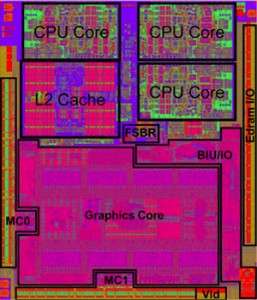The strange thing about that picture, which you did mention in part, is only one of the H/G duplicates seemed to be included in the UVD. It also makes Llano's seem smaller than Brazos' because of the way that picture breaks it up. I still believe the Q blocks match the one in Llano under the block I feel is like W. The block that has it's memory to one side. I think both from a fab size (I understand your other post on this, but I think H/G are way too small. 1 block is 19% of 1 Q's area), SRAM block sizes (I had counted five different sizes in Llano and Latte), and total SRAM amount perspectives it makes more sense. It would just be trying to figure out what it does in Llano.
I gotcha. I think my opinion of no MCs in Latte is why I don't see the same thing.
No, you're doing it wrong. It's
BS multipliers.

I was putting this together anyway (attempting to reaffirm the discussion between Fourth and myself), so it should help answer your question at the same time. I'm referring to that large pool of SRAM within the block itself. Here is a picture of the Sequencer (UTDP) in Brazos compared to the block I think is the same in Latte. Also here is picture for the Shader Export. I rotated and flipped both blocks from Brazos to a similar position as the ones in Latte.
UTDP
Shader Export
As I understand it, it was the tessellator itself in ATi/AMD GPUs that sucked. And that it wasn't till the introduction of the 7th generation of tessellators in some of the 6000 series that they were deemed useable.



